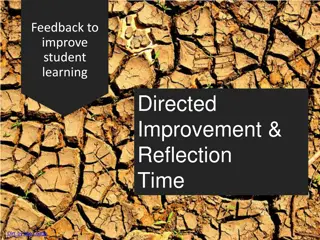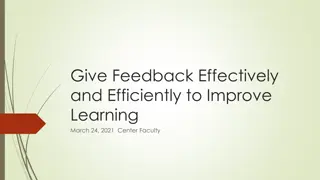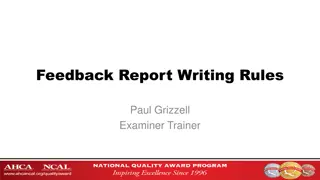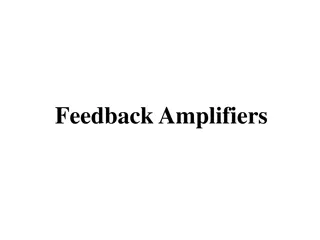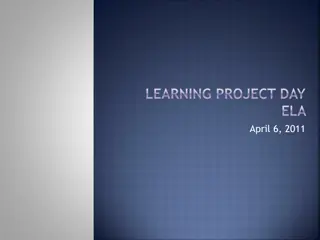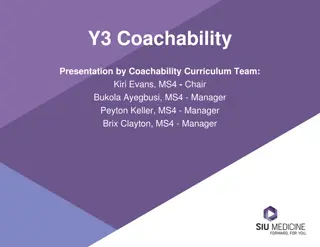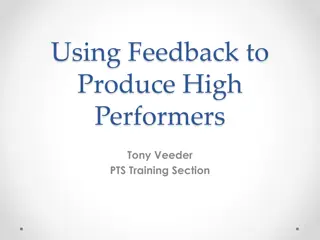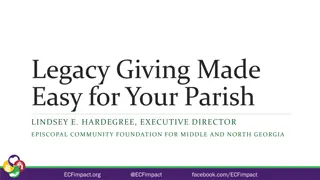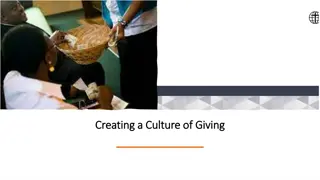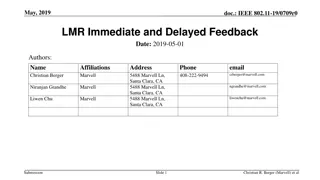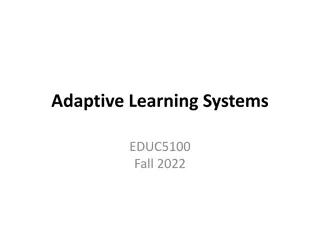Mastering the Art of Giving Feedback
Learn the importance of feedback, how to provide it effectively, and why it is crucial for personal and professional development. Explore the positive impact feedback can have on performance, motivation, self-awareness, and insights. Discover practical tips on giving constructive criticism and creating a culture of feedback.
Download Presentation

Please find below an Image/Link to download the presentation.
The content on the website is provided AS IS for your information and personal use only. It may not be sold, licensed, or shared on other websites without obtaining consent from the author. Download presentation by click this link. If you encounter any issues during the download, it is possible that the publisher has removed the file from their server.
E N D
Presentation Transcript
THE ART OF GIVING FEEDBACK Dr. Ramesh Mehay, Bradford VTS
OBJECTIVES The purpose of feedback The positive spirit of feedback How to do it What to do when it goes wrong Some ground rules Formal methods of feedback The emotional bank balance concept
1. THE PURPOSE OF GIVING FEEDBACK
How can we expect people to change and develop if they don t know what they need to change? Unless they get feedback, how do they know what they do well so they can continue doing it?
FEEDBACK IS: information about performance or behaviour that leads to action to affirm or develop that performance or behaviour.
WHY DO WE GIVE FEEDBACK
WHY TALK ABOUT FEEDBACK? Giving effective and constructive criticism is one of the most common concerns of educational supervisors Many consultants and GP trainers feel ill prepared in giving feedback on performance Yet: The most powerful single modification that enhances achievement is feedback. It permeates through the whole of GP training. And it features in ALL aspects of our lives It s a life skill (happy families)
2. THE POSITIVITY OF FEEDBACK
THE POSITIVITY OF FEEDBACK Bringing out the best Feeling empowered Motivating Improving performance Raising self awareness (cog dis) Enabling change Developing insight
THE POSITIVITY OF FEEDBACK Most people really want to know how they are doing. They want to know if other people like what they re doing. They also want to know if something could be done more effectively or if boundaries are being overstepped.
3. THE ART OF GIVING FEEDBACK
A FEEDBACK EXPERIENCE Think back to a situation when you received feedback. What happened? How did you FEEL? What did you THINK? 1. So was it positive or negative? 2. What was it about the content that made it good or bad? 3. What was it about the process that made it good or bad? 4. Was there anything about YOU that made it good or bad? 5. Did you gain a new insight? If not, why not? 6. Did you reflect, learn and plan? If not, why not? 7. Did anything change? If not, why not? What might have helped it change?
FEEDBACK IS NOT ABOUT: Praise or blame, approval or disapproval. How well you did in a test or exercise. Telling a person what to do. Making premature judgements about a person. CRITICISM is about dumping anger, telling people how they should be. FEEDBACK is about real life and your normal day to day work/activities. It s designed to reinforce or change behaviour.
YOUR STARTING POINT Positive Mutual respect Genuineness Giving time Enthusiasm Unconditional positive regard Negative Humiliation Commenting on personality No time for discussion Lack of interest Given too late
BEFORE YOU GIVE FEEDBACK Always ask yourself: What is my intention behind giving this person feedback? How am I feeling about giving it? How is the other person feeling BOTH PEOPLE (GIVER & RECIEVER) SHOULD BE IN A GOOD ENOUGH STATE
WHEN YOU GIVE FEEDBACK TIMELY - close to the event as possible, right time, right place SELECTIVE 2/3 key issues not 22! BALANCED - between good and bad SUGGESTIONS - rather than PRESCRIPTIONS DESCRIPTIVE - not judgemental SPECIFIC - or focussed - Avoid personal comments - Avoid Mixed Messages - Avoid diffusion DIRECTED - towards behaviour that can be changed (not personality) (Brown & Leigh s Feedback Rules, 1996)
MICRO-SKILLS Active Listening Response to Cues Open Questions Challenge Summarising Facilitating Reflection Enabling insight creating empowering cognitive dissonance.
EXAMPLE S CAN YOU IMPROVE ON THESE? "I think your selfish in that you don t listen to anyone else". "I notice that you don t look at people when they are talking to you". I really don t like your face it s so miserable looking at times It would help me if you smiled more or looked at me when you speak John, you always look as if you have just got out of bed but your work is good on the whole John, I would like you to take more care with your appearance in order to make a better impression Richard - you are not Read coding very well. You have to improve. Richard,I ve noticed that sometimes you re not Read coding a diagnosis. Can we talk about it & work out some plans to improve?
WHAT IS BEHAVIOUR? Exercise in pairs 5 minutes
ITS ABOUT THE GOOD STUFF TOO Positive reinforcement increases the likelihood that a behaviour will be repeated Motivation Increases when success is expected Motivation decreases when a goal is perceived as impossible But unfortunately, often only the negative aspects are commented on and/or remembered.
4. DOING FEEDBACK BADLY
BAD THINGS TO DO Deny the other persons feelings Be vague Accuse Take for granted the person has understood Bring in third parties Be negative Be destructive Be judgemental Bring up behaviours that the person cannot help Be overly impressed Be aggressive
There are 4 undesirable ways a trainee may respond to feedback BUT there 5 ways a trainer might respond to this in a counter- productive way Whilst you might not be able to control the trainee s initial response, you can control the responses after that
THE UNDESIRABLE WAYS A TRAINEE & TRAINER CAN RESPOND TRAINEE 4 ways 1. Denial 2. Rationalise 3. Anger 4. Blame TRAINER 5 ways 1. Colluding 2. Obligation 3. Moral high ground 4. Burying and fudging 5. Minimising Jennifer King, Psychologist, BMJ 1999
VIDEO CLIPS DEMONSTRATING THESE http://vimeo.com/album/1537045
BETTER WAYS OF RESPONDING Name and explore the resistance Keep the focus positive Try to convince the trainee to own one part of the problem Negotiate Allow time out Keep the responsibility where it belongs
5. METHODS OF GIVING FEEDBACK
EXERCISE - METHODS Exploring Pendleton Exploring SET-GO Exploring ALOBA
PENDLETON The trainee comments on strengths The trainer reinforces and adds The trainee comments on weaknesses The trainer reinforces and may add With evidence and suggestions
SET - GO What did you See? What Else? What do you Think, John? What Goal would you like to achieve? Any Offers on how we should get there?
ALOBA Can go straight to the hot issue ..it is agenda led!
GIBBS Neat tool for tackling the emotionally charged case discussions or consultations .
ABCDE OF FEEDBACK Approach Sensitive to the person and their learning agenda Balance Of positives and negatives as per Pendleton. Credits to exceed Withdrawals to avoid an Emotional Overdraft Change To facilitate Change by Active Listening, responding to Cues to and providing Challenge. To identify their problem and, through skill rehearsal, to work on their solution. As per SET GO Description Feedback based on fact and not on opinion throughout. Exact Feedback focusing on specific areas throughout.
6. FINAL COMMENTS
TALKING TO YOUR TRAINEE ABOUT FEEDBACK - getting onto the same wavelength
PROMOTE A SHARED UNDERSTANDING Read or listen carefully Understand seek clarification, examples, suggestions Give it time to sink in - get it into perspective Identify, Action Plan Try not to feel devastated - by small criticisms Try not to be defensive by making excuses; be receptive. Remember that it is being given with good intention. Remember that it may not have been easy to give.
EMOTIONAL BANK BALANCE Credits must be in place before withdrawals are made Credits must exceed withdrawals To avoid an emotional overdraft that is ultimately unsustainable The balance of support and challenge
FEEDBACK AS A GIFT Is this gift useful to me now? How was it wrapped? Can I find a use for it (if not immediately obvious)? If it s not a useful gift, might it be useful later? Would a similar gift be useful for others? How would I feel if I didn t get a gift? How would I feel if other people got gifts all the time and I got none? Am I careful how I choose and wrap my gifts? When I give a gift, am I being clear it really is for them?
FEEDBACK IS A LIFE SKILL The more you do it, the better you become. Improves all parts of your life. There are better ways to provide feedback, but there is no wrong way . Just do it!



